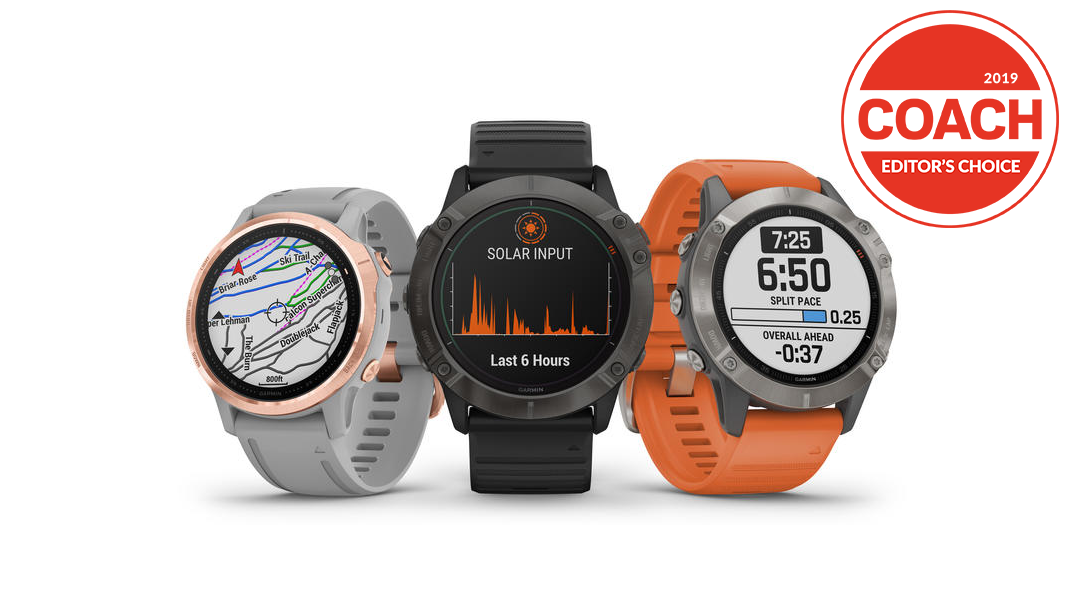Our Verdict
The best all-round sports watch available, with an appealing design and top-class features including maps and music on top of excellent sports tracking and training analysis.
For
- Colour maps
- Superb sports tracking
- Insightful training analysis
- Great battery life
- Music storage
Against
- Expensive
- Large, heavy design will not appeal to all
You can trust Coach
The Fenix 6 series from Garmin offers the most extensive range of features you’ll find on any of the best running watches and best fitness smartwatches, marrying excellent tracking and detailed training analysis with smart features like music storage and navigation using built-in colour maps. The watches are also lighter and slimmer than the Fenix 5 range, with bigger screens and longer battery life, especially if you opt for one of the devices that have solar panels on the watch face to extend the battery life. The Garmin Forerunner 945 is the only watch that can match the Fenix 6 for features, though the latter has a more upscale, less sporty design. The only real downside is that you’ll have to shell out a pretty penny to get your hands on it.
Should I Consider Buying Something Else?
Before considering anything else, you should decide which of the Garmin Fenix 6 range is right for you, which may take some time. There are more than 20 options in total, split across several models, with each model offering different combinations of features.
This review focuses on the 6 Pro and the features covered apply to any Pro variant in the range. It’s also the model I recommend. The cheaper Fenix 6 models lose music and maps, but since they’re only £70 cheaper and you’re already spending over £500, it’s worth the extra money – especially to get the maps, which are brilliant.
If you’re prepared to spend even more, then the Fenix 6 Pro Solar (£739.99) is an upgrade that brings solar panels to the face of the device. These can extend the battery life in watch mode by a couple of days, or add a few hours of GPS tracking, at an admittedly huge extra cost.
The other upgrade worth mentioning is the titanium version of the Fenix 6 Pro. While this is £200 more than the standard steel version, the titanium Fenix is lighter at 72g vs 83g. It might not seem a huge difference, but it is considerably more comfortable on the wrist. If you’re leaning towards the Forerunner 945 because it is so much lighter than the steel Fenix 6 Pro, the titanium Fenix gives you another option (sorry to complicate your decision further).
The quality and array of features on the 6 Pro and the relative lack of them among the flagship watches offered by Polar and Suunto means that the only real competition for it comes from within Garmin. To get the sports tracking, in-depth training analysis and smart features likes music and maps covered in this review, your choices are one of the Fenix 6 Pro watches, the cheaper Garmin Forerunner 945 (£519.99), which has a lighter, plastic design, or the Garmin Marq Athlete, which costs £1,399.
The Forerunner 945 is the 6 Pro’s main rival, then, and its lightweight, slim design will appeal to ardent runners and triathletes, especially because its optical heart rate tracking is more accurate than the Fenix 6 Pro’s, perhaps because of the lighter design. The 945 is also due to get the PacePro feature introduced on the Fenix 6 in time, so really, choosing between the two will mostly come down to weighing up which design you prefer – the larger screen of the 6 Pro and the £80 you can save by opting for the 945.
Sign up for workout ideas, training advice, reviews of the latest gear and more.
Garmin Fenix 6 Pro In-Depth
Running With The Garmin Fenix 6 Pro
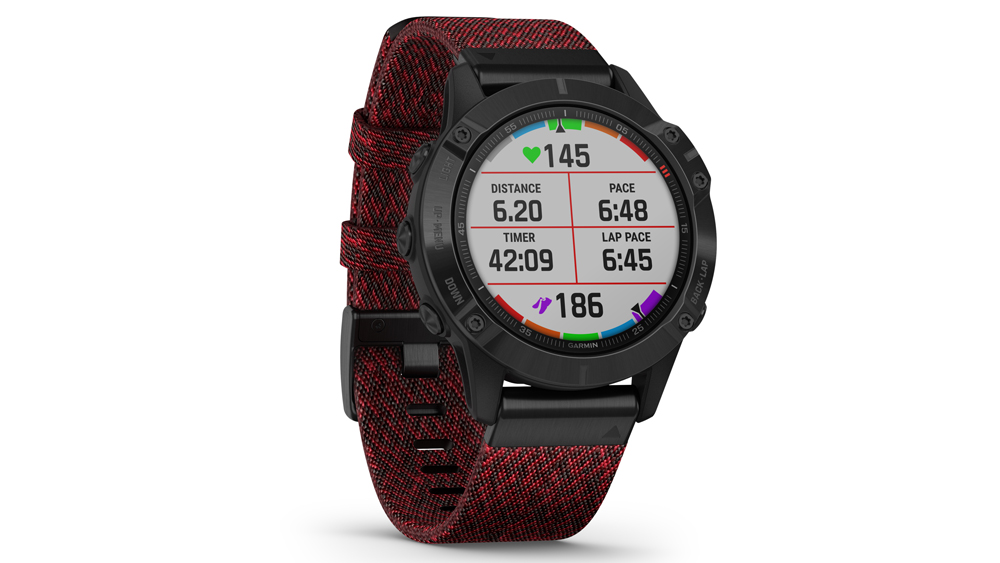
Six stats on a screen is a good place to start here (eight if you opt for the Fenix 6X Pro), because it’s something I’ve wanted on a Garmin watch for some time. One of those stats can be a colour-coded heart rate gauge so you can see which zone you’re working in easily. It’s great, and exactly what I’d hoped for when Garmin said the screen size was bigger on the new watches. Well, on most of them – it’s now 1.3in (33mm) on the 6 and 6 Pro and 1.4in (35.5mm) on the 6X Pro, but still 1.2in (30.5mm) on the 6S and 6S Pro.
All the usual staples of a Garmin are in place too. The watch uses American GPS, Russian GLONASS and European Union Galileo (you can pick two of the three to use) satellites to get a fast lock at the start of your run and then track it accurately. It’s easy to create and load structured workouts on the watch, and you can also sync over full training plans from the Garmin Coach feature in Garmin Connect.
The navigation features are also top-notch. The Fenix 6 Pro can create looped routes for you when in a new place based on distance and direction, or you can just head off into the unknown and get it to work out a route home on the fly once you’ve had enough of exploring.
As for new features, it’s PacePro that really stands out as something that’s likely to become invaluable for many runners on race day.
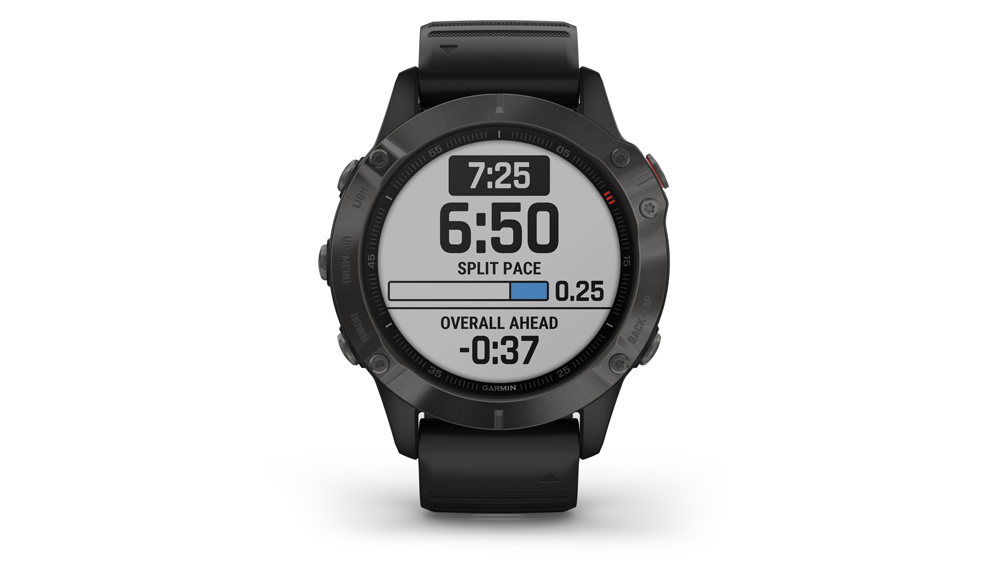
PacePro is designed to help you pace your runs to take into account the hills on your course, your overall target pace and whether you want to do the second half of your run faster (known as a negative split). This feature sets individual split targets for each mile or kilometre of your run based on that information. For example, if you want to run a half marathon at an average of five minutes per kilometre, you might be told to run the first kilometre in 4min 50sec knowing that the second one will be 5min 10sec because there’s a hill in it.
I have always paced my races on one-kilometre or mile splits anyway – I find working to the next split is the best way to keep focused and upbeat, rather than thinking about the whole amount you have left to run – so the idea of PacePro certainly appealed. Fortunately I had a half marathon on undulating terrain lined up just ten days after I got hold of the Fenix, so I duly mapped out the course in Garmin Connect and set my targets: I planned to run the first 10K at a steady pace and cut loose in the second half, so I set it up for a negative split.
My main fear with PacePro was that it would be useless as soon as GPS tracking went slightly off-track, which happens in pretty much every race. However, having the course loaded seemed to improve things on that front – the PacePro splits and distance markers in my race matched up as close to perfectly as I could expect. The same was true when I later used PacePro for a marathon, once again on undulating terrain.
I was hugely impressed with PacePro. The variable split targets are a great way to keep your focus and let you know what’s coming up in the next kilometre or mile. You are also told how far ahead of or behind your overall target you are. In my race I ended up going quite a bit faster than my original overall target, but even then I checked each PacePro individual split to see if I was facing some uphill sections, or was expected to pick up some time on downhills.
It’s a feature that essentially creates a smart pacing band and will be at its best on undulating courses, but it will also be brilliant for pacing a negative split – the best way to nail a PB – in flat events.
Garmin has had a virtual race pacer mode on its watches for some time, which used an overall target time and distance to keep you on track, but breaking it down into individual splits with PacePro makes it far more useful. I can foresee potential problems if the route of your run strays from the PacePro plan at all, but even then you can just switch back to your normal run screen.
Another new addition to the Fenix range also focuses on performance. The watches all get the in-depth training analysis previously only available on the Forerunner 945 and Marq Athlete. This will track how well you’re responding to heat or altitude, and break down your previous four weeks of training into three categories – anaerobic, high aerobic and low aerobic. Based on that info you’ll get advice on whether your training is balanced or not, and how you can improve it.
This feature does depend heavily on accurate heart rate tracking, however, and so far I’ve had mixed results on that front. It’s been spot-on for about half my runs, and recorded far too high a heart rate in the others. This results in the run being recorded as a high aerobic or anaerobic effort, which then throws off the training load analysis for four weeks. As a result I opted to link up a chest strap heart rate monitor to the watch for all my runs after a couple of weeks. It’s a small hassle that’s worth it for the accurate training analysis, but when I tested out the 945 the optical tracking was accurate enough that I didn’t feel the need to wear a chest strap.
Aside from the heart rate tracking problems the Fenix 6 Pro is a flawless running watch that offers more features than anything else out there. It’s worth asking whether you actually need all those features, because something like the Forerunner 245 Music covers all the essentials, even including music and breadcrumb navigation, for £299.99. Most runners will probably be well served by a cheaper watch, but it’s undoubtedly fair to say if you want the best available, it’s the Fenix 6 Pro. Its only real rival is the Forerunner 945, and that’s only once it gets PacePro.
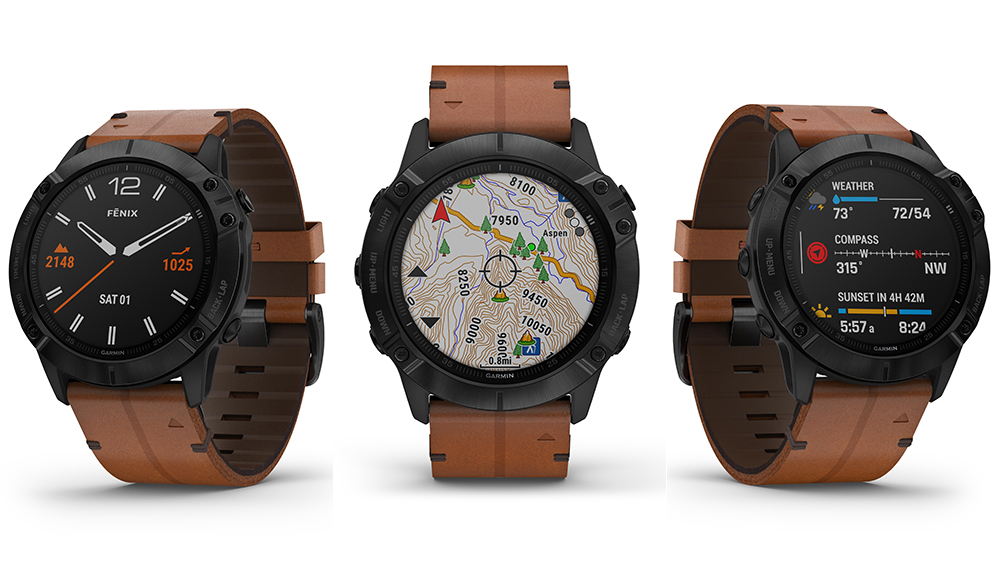
Sports Tracking With The Garmin Fenix 6 Pro
The Fenix 6 Pro is a full triathlon watch and also tracks a multitude of other sports, though the detail provided is fairly light once you extend outside running, cycling and swimming. For cyclists you can pair up power meters and other sensors with the watch (over Bluetooth and ANT+), while swimmers get a host of sport-specific stats like SWOLF and stroke rate.
Swimmers will also be able to use the optical heart rate tracker on the watch, which is a first for Garmin, which has turned off heart rate tracking in swimming modes in the past across all its watches. This was because it’s not all that accurate in the water, and that caveat still applies with the Fenix 6 Pro – flailing your arms in and out of water is not ideal for getting a fix on your pulse at the wrist. Pairing a swim-specific chest strap is the best way to go for accuracy purpose, but it’s good that Garmin has allowed the option to use the optical sensor, at least.
Another sports mode that gets a little more attention is strength workouts, with the Fenix 6 Pro courting your reps for you and even identifying which exercise you’re doing in the gym. This works well for some exercises, like the bench press, but is pretty inaccurate with many others, though you can check and edit the details yourself in Garmin Connect afterwards.
Activity Tracking With The Garmin Fenix 6 Pro
The Fenix 6 Pro is a good-looking watch that you’ll want to wear everywhere. Should you do so, you’ll get a wealth of information about your everyday activity, along with alerts to move if you’ve been sedentary for too long (you can switch these off, if you’d like to) and celebratory graphics when you hit your steps or floors-climbed goal. The steps goal is also automatically adjusted depending on past activity, with the idea that it stays challenging but within reach.
Along with standard stats like steps, calories and the like, the Fenix 6 Pro also uses your heart rate variability to estimate your levels of physical stress and, along with other information, provides a rating of your overall energy out of 100, which is called Body Battery.
People who spend £600 on a sports watch probably aren’t hugely motivated by everyday activity goals, but it can help you keep moving in between your training sessions, and the Body Battery rating is a good indication of whether you have the energy to undertake any harder workouts you might be planning.
Using The Garmin Fenix 6 Pro As A Smartwatch
Garmin has introduced music to several of its running watches and done so very successfully, largely because it has a partnership with Spotify so Premium users can sync music to the watches wirelessly. It makes things much more convenient than plugging in to transfer music. You can also do this with Deezer accounts or transfer your own playlists of music you own using the charging cable and the Garmin Express programme.
There’s no other serious sports watch out there with space for music. It’s not something Polar, Coros or Suunto offers as yet, and smartwatches from Fitbit, Apple, Samsung and the like don’t get close to the quality of sports tracking offering by the Fenix 6 Pro, or even Garmin’s cheaper sports watches with music.
The other smart feature on the 6 Pro, however, remains something of a flop. Garmin Pay is still only available through a few banks – Santander is the only UK high street bank on the service – and third-party services.
Sleep Tracking With The Garmin Fenix 6 Pro
Garmin still hasn’t embraced sleep tracking in the same as way as Polar and Fitbit, whose devices offer a huge amount of detail on your night’s rest. The Fenix 6 Pro will break down your sleep into light, deep and REM sleep, and log any periods awake, but beyond that all you get is a graph of your movement in the night.
It’s also not that accurate, suffering from the same problem that I’ve had with all Garmin watches: they tend to log periods when you’re awake but still – reading or watching TV, say – as light sleep, so you end up with skewed overall time asleep stats.
How Often Am I Going To Have To Charge It?
The battery life of the Fenix 6 watches varies across the range but is uniformly very good. The smallest Fenix 6S and 6S Pro watches offer 25 hours of GPS, the Fenix 6 and 6 Pro 36 hours, and the 6X Pro has a mighty 60 hours of GPS. Those numbers take a hefty hit if you use music – down to six hours on the 6S, ten hours on the 6, 15 hours on the 6X – but even so, turn off the tunes and you should always be able to make it to a charger in time.
Opt for the most expensive watch in the range – the 6X Pro Solar – and you can also get an extra 10% of battery life thanks to the tiny solar panels on the watch face. Hopefully this is a sign of things to come with Garmin’s watches, because the idea of never having to plug in thanks to your solar-powered watch is very appealing, although that might be a pipe dream in these cloudy climes.
Fenix 6 Pro Solar
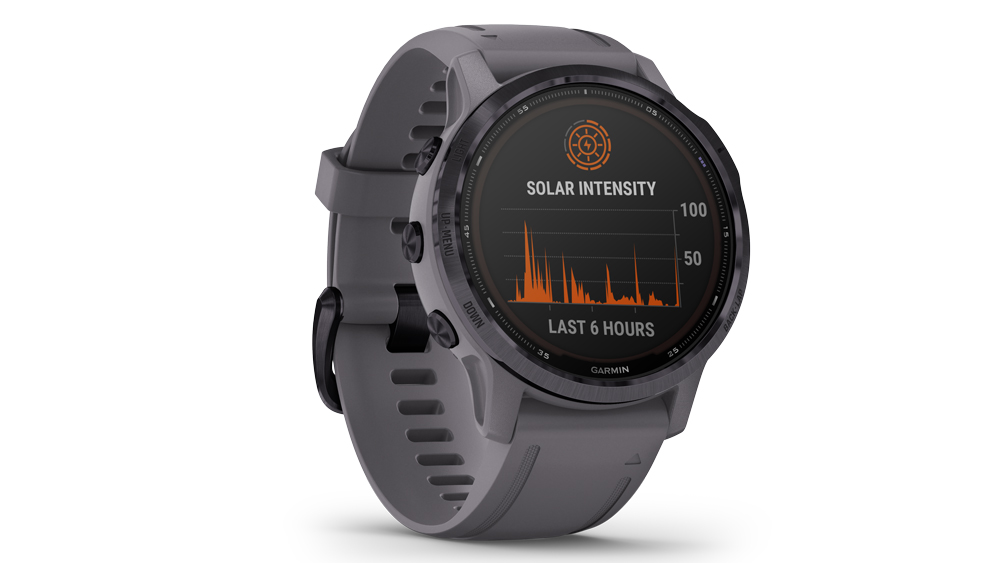
When the Fenix 6 series first launched only the top-of-the-line (and very expensive, even for a Fenix) 6X Pro Solar had solar panels on the watch face. I was hoping that in time this was something Garmin would bring to other watches, and that is exactly what has happened, with solar options coming to both the Fenix 6S Pro and 6 Pro.
The solar panels are added in a discreet and stylish way to the watch in a ring around the watch face. The screen and device are the same size as on the standard 6 Pro, with Garmin accommodating the panels by making the black dial around the screen thinner on the 6 Pro Solar.
While the battery life gained isn’t huge, it’s impressive for such a slim ring. The 6 Pro Solar lasts 14 days in watch mode and offers 36 hours of GPS, numbers that increase to 16 days and 40 hours of GPS if the panels come into play. Wearing a Fenix 6 Pro on one wrist and the 6 Pro Solar on the other I’ve noticed a percent or two less drain on the Solar on days where I was outside for a decent chunk of time.
You don’t have to be in blazing sunshine for the panels to charge. The Solar Intensity widget and dedicated watch faces on the Fenix 6 Pro Solar show how much sun it’s getting at any time, and I found that the dial would be three-quarters full when outside even on cloudy days. You can also have a graph on the watch face that shows how much sun the watch has been getting for the past six hours.
The Solar editions cost £140 more than the standard Pro devices, starting at £739.99, so you are paying a lot more for a fairly small improvement in battery life. Only you will know whether the increased battery is worth the extra cost to you, but hopefully in time it will become a standard feature on the Fenix.
Where Can I Wear It Without People Laughing At Me?
Everywhere. The Fenix 6 Pro is a great-looking watch and you can easily switch out the sporty silicone strap it comes with for leather, nylon, metal or titanium versions. Depending on the size of the Fenix 6 you’re buying, you’ll need a QuickFit 20, 22 or 26 watch band (£89.99-£269.99).

Nick Harris-Fry is a journalist who has been covering health and fitness since 2015. Nick is an avid runner, covering 70-110km a week, which gives him ample opportunity to test a wide range of running shoes and running gear. He is also the chief tester for fitness trackers and running watches, treadmills and exercise bikes, and workout headphones.
